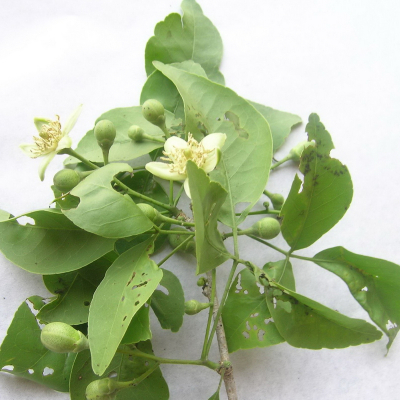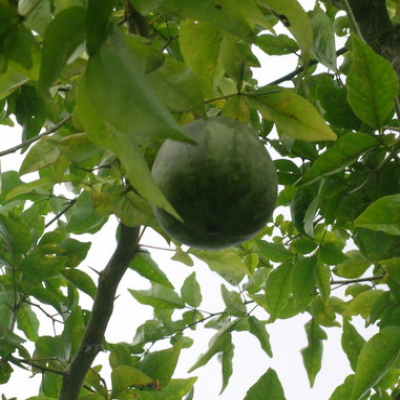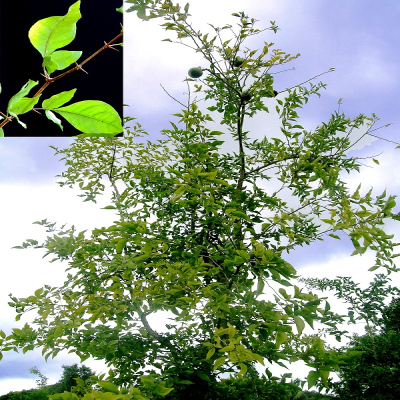Aegle marmelos (Linn.) Corr.
Synonyms : Feronia pellucida Roth, Crataeva religiosa Ainslie
Family : Rutaceae
Group : 1. Dasamoolam, 6. Star trees, Antidiabetic
Parts Used : Root , Fruit , Leaf , Stem
Vernacular Names :-
| English | : | Bael tree, Holy fruit tree |
| Malayalam | : | koovalam |
| Hindi | : | Bel |
| Sanskrit | : | Bilva, Sriphal |
| Assamese | : | Bel |
| Bengali | : | Baela |
| Gujarathi | : | Bil |
| Kannada | : | Bilvapatra |
| Tamil | : | Vilvam |
| Telungu | : | Bilvapendu |
Botany: Medium-sized deciduous tree growing up to 8 m in height with straight sharp axillary thorns and yellowish brown shallowly furrowed corky bark.
- Leaves: Alternate, trifoliate and aromatic; leaflets ovate; the laterals subsessile.
- Flowers: Terminal, long-petioled, greenish-white, sweet-scented.
- Fruits: Hard-shelled berry, globose, 6 -10 cm in diameter.
- Seeds: Oblong, compressed and embedded in the orange brown sweet gummy pulp, 80-100 seeds per berry.
Chemical constituents:
- Leaves contain an alkaloid rutacin which is hypoglycaemic
- Roots and fruits contain coumarins such as scoparone, scopoletin, umbelliferone, marmelosin and skimmin.
- Fruits, in addition, contain xanthotoxol, imperatorin and alloimperatorin and alkaloids like aegeline and marmeline identified as N-2-hydroxy-2-[4-(3’,3’-dimethyl allyloxy) phenyl] ethyl cinnamide. Roots and stem barks contain a coumarin - aegelinol.
- Fruit pulp is a rich source of carbohydrate, protein, fat, fibre, minerals and vitamin B and C.
Properties & Uses:
- The roots are used in many ayurvedic medicines for curing diabetes and leprosy. It is an ingredient of the ‘dasamoola’.
- Bark is used to cure intestinal disorders
- Leaf is anti-inflammatory, expectorant, anticatarrhal, antirheumatic, antiasthamatic, antipyretic, antiulcerous and ophthalmic. Leaves and fruits are useful in controlling diarrhoea and dysentery.
- Flower is emetic.
- Fruit pulp is used to cure mouth ulcers as it is one of the richest natural source of riboflavin. The ripe fruits are laxative and tonic and good for heart and brain
- Seed is anthelmintic and antimicrobial.
Agrotechnology
Propagation: By seeds. North Indian varieties are preferred to South Indian types for large scale cultivation. 2 months old seedlings can be planted at a spacing of 4m x 4m.
Varieties: North Indian varieties are preferred to South Indian types for large scale cultivation. Kacha, Ettawa, Seven Large, Mirsapuri and Deo Reo Large are varieties meant specially for ‘Sharbat’. Some improved selections are NB-7, NB-5, NB-9, NB-17, Pant Aparna, Pant Sujata, Pant Shivani etc.
Manuring: Apply FYM at the time of planting and thereafter every year with the onset of monsoon. Chemical fertilisers are not usually applied. However NPK recommended is 480 g N, 320 g P and 480 g K/tree/year.
Irrigation: Regular irrigation is required during early stages of growth once established, light irrigation should be given after manuring and fertilization and proper soil moisture may be maintained after fruit set.
After cultivation: Regular weeding is required during the early stages of growth.
Plant protection: Fruit canker, fusarium wilt, and fruit cracking are major problems.
Harvesting: Bael tree flowers during April. The flowers are aromatic with pleasant and heavenly odour. The fruits are set and slowly develop into mature fruits. Fruits are seen from October-March. A single tree bears 200-400 fruits. Fruits are usually packed in gunny bags, baskets or wooden crates using newspaper as cushioning material. Roots can be collected from mature trees of age 10 years or more. Tree is cut down about 1 m from the ground. The underground roots are carefully dug out. Roots with the attached wood are then marketed.



